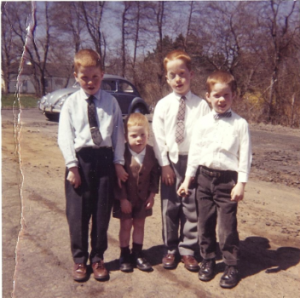Netflix is now streaming a documentary about five Hollywood directors who volunteered to serve the US Armed Forces in World War 2. One early part of their work was the Private Snafu series, with later and greater films to follow.
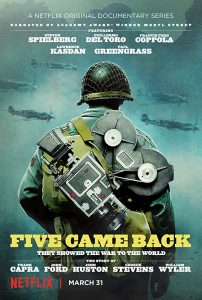
Netflix is now streaming a documentary about five Hollywood directors who volunteered to serve the US Armed Forces in World War 2. One early part of their work was the Private Snafu series, with later and greater films to follow.

Here’s Bonnie Poe (once of the voice actors for “Betty Boop”, the Queen of American cartoons) with Bela Lugosi as a wax works Count Dracula, who puts the bite on Betty with the threat, “Betty … you have Booped your last Boop”.
The scene is from 1934’s “Hollywood on Parade”. The characters are wax work figures who’ve been animated (quite appropriately in Betty’s case).
This is the story of one family’s bold adventures in America, ranging from distant European lands through the Great War, Appalachian coal mines, and the Golden shores of California for their triumphant success in the modern age.
The musical score, in order of performance.
“Private Snafu – the 2nd Front” is now available in the Microsoft Windows Store! This is a new app, rewritten in UWP* for your Windows 10 tablet, laptop, desktop and Enterprise server! All new code with all old content! Private Snafu comes in two All American languages – English and Español (the sound track is the delightful original, with Mel Blanc’s silver tones, but titles and historical notes are multilingual).
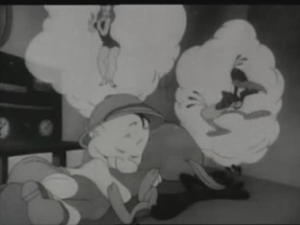
“Private Snafu – the 2nd Front” is here and * FREE * for everyone running Windows 10! And who isn’t running Windows 10? Seriously, if you’re not, Satya Nadella has an upgrade waiting for you!
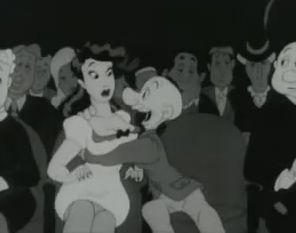
Are you one of the many people still running Windows RT** on your ARM tablet? Not to worry – we are keeping the first edition “Private Snafu” around for both of you!
https://www.microsoft.com/en-us/store/p/privatesnafu/9wzdncrfjxnz

Microsoft Store link to “Private Snafu, the 2nd Front”

En 07 de diciembre de 1941, los USA inesperadamente se sumieron en la mitad de la segunda guerra mundial. Hubo mucho pánico, la confusión y la mudos meteduras hechos desde el principio.

Hollywood al rescate! La “Oficina de guerra de información” fue fijado hasta educar e influir en el general público con lo que podrían conseguir sus manos en – periódicos, revistas, radio y cómics incluso. Bajo la dirección de general de brigada General Frederick Osborn, películas fueron seleccionadas como el mejor medio y los alistados servicio de hombres y mujeres como el mejor destino. Estos nuevos reclutas fueron fresca y llena de espíritu, pero vinieron de todos los ámbitos de la sociedad, de manos de campo que apenas podía leer a capitanes de industria usada al comando.
![Private Snafu (8)[1]](http://frostbackcrow.com/Fun/wp-content/uploads/2016/06/Private-Snafu-81-300x221.jpg)
Director de cine Frank Capra fue elegido para dirigir al equipo de la película educativa. Él produjo una serie de cortos de propaganda llamado “Why We Fight”. Eric Knight, el escritor que creó el perro de la legendaria película “Lassie”, ha añadido algunos pedacitos animados a estos cortos. Esas caricaturas tiene algunas de las mayores risas de su público, por lo Capra mirado de hacer una nueva serie de dibujos animados diseñado para enseñar a reclutas crudos lo que debe hacer. Las ofertas que hacen estos, con Walt Disney había considerado el más probable ganador. Sin embargo, Disney quería mantener los derechos de cualquier personajes creados, además de que ponen en una oferta más alta. Animación de la Warner Brothers productor Leon Schlesinger oferta baja y ganó la oferta, incluyendo el mantenimiento de los caracteres en el dominio público.
Los dibujos animados sería corta y hecho en blanco y negro, para mantener los costos bajos. Schlesinger utiliza su mejor talento personal “Looney Tunes” y “Merrie Melodies”, con directores de Bob Clampett, Friz Freleng (inspiración para “Yosemito Sam”), Chuck Jones y Frank Tashlin. El magistral Mel Blanc proporcionó voces. Capra había elegido a Ted Geisel (que se convertiría en “Dr. Seuss”) como el escritor principal. En el transcurso de la serie, otros añadiría sus talentos.
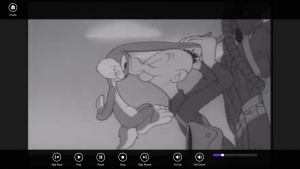
Schlesinger decidió educar por contraejemplo y surgió con un “hombre común” que lo hizo todo mal por ignorancia y pereza. Private Snafu fue introducido en 1943 “venida!” que también explica su nombre. “SNAFU-situación Normal, todo… Sucias para arriba”. La primera serie de dibujos animados cubre asuntos militares básicos como rumor regular control (“rumores”), pereza (“el Goldbrick”), mantenimiento de equipos (“lucha herramientas”, “Gas”). Mantener secretos militares fue otro tema, con “Espías” y “Censurado”. Munro Leaf, quien escribió “La historia de Fernando”, también escribió a “El Chowhound” sobre no desperdiciar alimentos (ambas historias con toros).
Porque las caricaturas Snafu sólo fueron pensadas para un público militar masculino adulto, había un montón de bromas sutiles y desnudez. En “la casa delantera”, Ted Geisel puso en una broma sólo para ver qué haría el animador-“(en Alaska) fue tan frío, congelaría las tuercas de un jeep”.
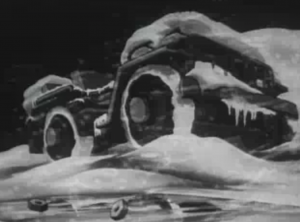
“Trampas cazabobos” literalmente habían incluido… una trampa!
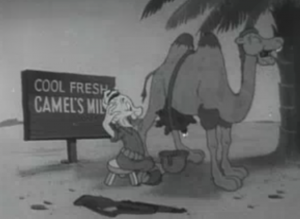
Los villanos de eje se dibujan muy desfavorable. Los alemanes son grandes, con sobrepeso y mudo. Los japoneses son pequeños con enormes gafas y los dientes aún más grandes. El racismo ocasional de la época de la guerra es discordante hoy.
Las caricaturas Snafu tuvo éxito porque entretuvo mientras que entrega sus lecciones breves en mantener secretos, engranaje o lío pasillo las tareas de limpieza. No sermones, y Snafu a veces había aprendido sus lecciones de finales. Como progresó la guerra y una victoria aliada se convirtió cada vez más probable, las caricaturas Snafu se convirtieron un poco más secas. “Unos pocos datos: inflación” y “Unos rápidos hechos: miedo” fueron realizado por el estudio de animación UPA con una diferente pero todavía divertido estilo. “Puntos calientes” (por Hanna y Barbera, que comenzó a “los Picapiedra”) nos muestra cómo sobrevivir en Irán, con su camello, calor de fusión. “En las islas Aleutianas” miradas en el fango, el viento y la lluvia de la cadena de islas de Alaska. Cuando terminó la guerra, también lo hizo la serie – el último de ellos, nunca fue lanzado “Privado SNAFU presenta marinero TARFU” (escrito por Hank Ketcham, de la fama de “Dennis la amenaza”).
Los estudios Warner batido hacia fuera una nueva historieta de Snafu privado cada mes (de vez en cuando con la ayuda de un estudio rival, como UPA y MGM) hasta el final de la guerra. Con un costo total de sólo $300.000, estas fueron algunas de las armas más baratas y ciertamente entre las más divertidas.
Esperamos que disfrute estas caricaturas de Snafu privado!
On December 7, 1941, the USA was unexpectedly plunged into the middle of World War II. There was a lot of panic, confusion and plumb dumb goofs made right from the beginning.

Hollywood to the rescue! The “Office of War Information” was set up to educate and influence the general public using whatever they could get their hands on – newspapers, magazines, radio and even comic books. Under the leadership of Brigadier General Frederick Osborn, movies were picked as the best medium, and the enlisted Service men and women as the best target. These new recruits were fresh and full of spirit, but they came from all walks of society, from field hands who could barely read to Captains of Industry used to command.
![Private Snafu (8)[1]](http://frostbackcrow.com/Fun/wp-content/uploads/2016/06/Private-Snafu-81-300x221.jpg)
The cartoons would be short and done in black and white, to keep costs down. Schlesinger used his best talent from the “Looney Tunes” and “Merrie Melodies” staff, with directors Friz Freleng (inspiration for “Yosemito Sam”), Chuck Jones, Frank Tashlin and Bob Clampett. The masterful Mel Blanc provided voices. Capra picked Ted Geisel (who would become “Dr. Seuss”) as the chief writer. Over the course of the series, others would add their talents.

Schlesinger decided to educate by counterexample, and came up with an “Everyman” who did it all wrong due to ignorance and laziness. Private Snafu was introduced in the 1943 “Coming!!!” which also explains his name. “SNAFU – Situation Normal, All ….. Fouled Up”. The first set of cartoons covered basic military topics like rumor control (“Rumors”), laziness (“The Goldbrick”), regular equipment maintenance (“Fighting Tools”, “Gas”). Keeping military secrets was another theme, with “Spies” and “Censored”. Munro Leaf, who wrote “The Story of Ferdinand”, also wrote “The Chowhound” about not wasting food (both stories featuring bulls).
Because the Snafu cartoons were only intended for an adult male military audience, there were a lot of subtle jokes and nudity. In “The Home Front”, Ted Geisel put in a joke just to see what the animator would do -“(In Alaska) it was so cold, it would freeze the nuts off a jeep”.

“Booby Traps” literally included … a booby trap!

The Axis villains are drawn very unfavorably. Germans are big, overweight and dumb. The Japanese are tiny with huge glasses and even bigger teeth. The casual racism of that wartime era is jarring today.
The Snafu cartoons succeeded because they entertained while delivering their brief lessons on keeping secrets, cleaning gear or mess hall chores. They weren’t preachy, and Snafu sometimes learned his lessons by the end. As the war progressed and an Allied victory became more and more likely, the Snafu cartoons became a little drier. “A Few Quick Facts: Inflation” and “A Few Quick Facts: Fear” were done by the UPA animation studio with a different but still entertaining style. “Hot Spots” (by Hanna and Barbera, who started “the Flintstones”) shows us how to survive in Iran, with its camel melting heat. “In the Aleutians” looks at the mud, wind and rain of the Alaskan island chain. When the war ended, so did the series – the last one, “Private SNAFU Presents Seaman TARFU” (written by Hank Ketcham, of “Dennis the Menace” fame) was never released.
The Warner studios churned out a new Private Snafu cartoon every month (occasionally with help from a rival studio, like UPA and MGM) through the end of the war. With a total cost of only $300,000, these were some of the cheapest weapons, and certainly among the funniest.
We hope you enjoy these Private Snafu cartoons!
We would love to hear from you how you enjoyed the features, suggestions you might have or problems encountered.
You can write to us at PrivateSnafu@Outlook.com.
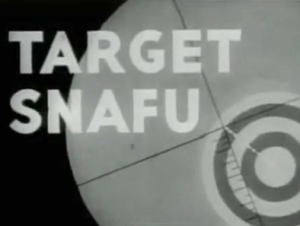
For us, it’s all about bringing you some of the highlights from the Golden Age of Cinema and Television, using the latest in technology! Please visit our advertisers, who keep this app free.
We respect your privacy and do not collect any information from our guests. Thank you, and enjoy the show!
